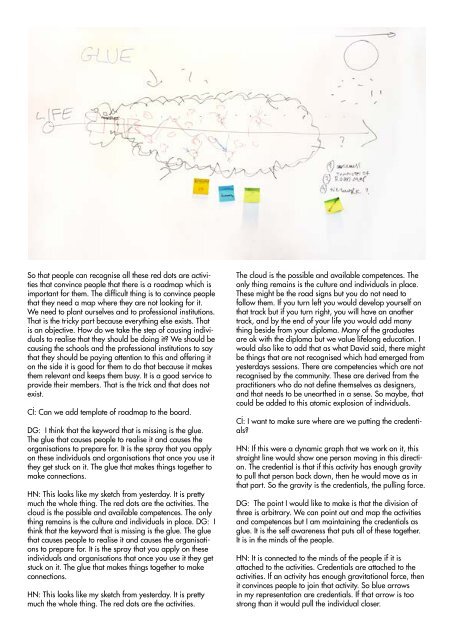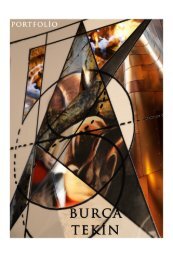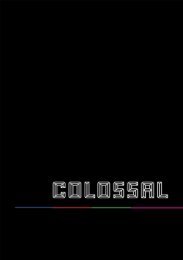BURCA TEKİN - 11535024 -
Create successful ePaper yourself
Turn your PDF publications into a flip-book with our unique Google optimized e-Paper software.
So that people can recognise all these red dots are activities<br />
that convince people that there is a roadmap which is<br />
important for them. The difficult thing is to convince people<br />
that they need a map where they are not looking for it.<br />
We need to plant ourselves and to professional institutions.<br />
That is the tricky part because everything else exists. That<br />
is an objective. How do we take the step of causing individuals<br />
to realise that they should be doing it? We should be<br />
causing the schools and the professional institutions to say<br />
that they should be paying attention to this and offering it<br />
on the side it is good for them to do that because it makes<br />
them relevant and keeps them busy. It is a good service to<br />
provide their members. That is the trick and that does not<br />
exist.<br />
Cİ: Can we add template of roadmap to the board.<br />
DG: I think that the keyword that is missing is the glue.<br />
The glue that causes people to realise it and causes the<br />
organisations to prepare for. It is the spray that you apply<br />
on these individuals and organisations that once you use it<br />
they get stuck on it. The glue that makes things together to<br />
make connections.<br />
HN: This looks like my sketch from yesterday. It is pretty<br />
much the whole thing. The red dots are the activities. The<br />
cloud is the possible and available competences. The only<br />
thing remains is the culture and individuals in place. DG: I<br />
think that the keyword that is missing is the glue. The glue<br />
that causes people to realise it and causes the organisations<br />
to prepare for. It is the spray that you apply on these<br />
individuals and organisations that once you use it they get<br />
stuck on it. The glue that makes things together to make<br />
connections.<br />
HN: This looks like my sketch from yesterday. It is pretty<br />
much the whole thing. The red dots are the activities.<br />
The cloud is the possible and available competences. The<br />
only thing remains is the culture and individuals in place.<br />
These might be the road signs but you do not need to<br />
follow them. If you turn left you would develop yourself on<br />
that track but if you turn right, you will have an another<br />
track, and by the end of your life you would add many<br />
thing beside from your diploma. Many of the graduates<br />
are ok with the diploma but we value lifelong education. I<br />
would also like to add that as what David said, there might<br />
be things that are not recognised which had emerged from<br />
yesterdays sessions. There are competencies which are not<br />
recognised by the community. These are derived from the<br />
practitioners who do not define themselves as designers,<br />
and that needs to be unearthed in a sense. So maybe, that<br />
could be added to this atomic explosion of individuals.<br />
Cİ: I want to make sure where are we putting the credentials?<br />
HN: If this were a dynamic graph that we work on it, this<br />
straight line would show one person moving in this direction.<br />
The credential is that if this activity has enough gravity<br />
to pull that person back down, then he would move as in<br />
that part. So the gravity is the credentials, the pulling force.<br />
DG: The point I would like to make is that the division of<br />
three is arbitrary. We can point out and map the activities<br />
and competences but I am maintaining the credentials as<br />
glue. It is the self awareness that puts all of these together.<br />
It is in the minds of the people.<br />
HN: It is connected to the minds of the people if it is<br />
attached to the activities. Credentials are attached to the<br />
activities. If an activity has enough gravitational force, then<br />
it convinces people to join that activity. So blue arrows<br />
in my representation are credentials. If that arrow is too<br />
strong than it would pull the individual closer.<br />
HE: I do not think that it is a one way process. Especially in designer’s life, going back of the process is important. I believe<br />
that this should be rather a circular map. I think if this is the life cycle of designer we can divide it by two. If we say everything<br />
starts with a curiosity then there is a credential somewhere. After got a diploma from a university you become a professional.<br />
In life, there are a lot of things such as these red dots. And then we come here with a lot of problems such as a bad<br />
design. On the action side, there is a lot of activities such as an outsourcing. But the designer is in the centre. In a dynamic<br />
way we can evaluate this periodically.<br />
DG: I believe it is very relevant and interesting but it is an another issue.<br />
HE: To conclude, there is a critical factor that evaluates the process that is specific for designers and create a passport for<br />
some reason.<br />
HN: The plug in part, what does it consist of? Where do they come from? Who are they?<br />
HE: This is the actor that we were discussing about.<br />
HN: It is a commission of thing. I think I would agree with David that it is a mother problem that value process but not a<br />
design education process. It is more a complete and larger picture.






